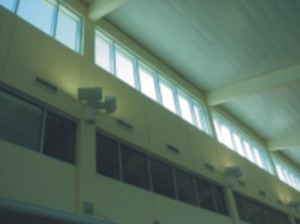
Easy Pickings
Next time you’re in an airport or shopping mall take a look-see at the skylights or floor to ceiling glass lined corridors and determine if the light fixtures are off. Nine times out of ten the lights will be blazing away into an area so bright you should be reaching for your Ray-Bans.
In addition to spaces obviously designed to introduce a large amount of natural light, there are other areas that will enable the harvesting of daylight. Lobbies, open area offices, classrooms, and restaurants are all possible candidates for daylighting if the right scenario presents itself.
Solutions
Unless your building has a drill sergeant with OCD walking around lambasting people for not turning off the lights when there is enough daylight, you’ll probably need some form of controls. Those controls can be as complicated as a Rube Goldberg contraption or as simple as screwing in a light bulb.
Simpler is Better
The simplest and most foolproof daylighting control is an astronomical timer (automatically compensates for changes in sunrise and sunset times) with on/off control that can be simply added to a lighting circuit. Another fairly simple type is a photocell with on/off controls. If all fixtures in an area can’t be turned off, try controlling just half the lamps, every other row, or the fixtures closest to windows/skylights. Simple controls are cheaper, more dependable, and provide the greatest return on investment.
Dimming controls are also another option and provide a great atmosphere that adapts to indoor and outdoor conditions throughout the day to provide consistent and balanced lighting.
The Downside to Dimming
Dimming systems are great if sensors and controls are installed and set up properly during the commissioning process, but this rarely happens in most buildings. Without proper setup and building staff that fully understands the controls, you may end up with lights that are flashing, flickering, or cascading on and off from one side of the room to another.
A common occurrence for complicated systems is that they are disconnected once they stop working as planned because the staff gets either frustrated with resetting the controls or inundated with complaints.
Simply More
Simple and easy to use controls may not make headlines with groundbreaking technology or produce a consistent and narrow ranging light level but they are reliable and affordable. Just because these controls don’t cost a small fortune, doesn’t mean they can’t save you one.




